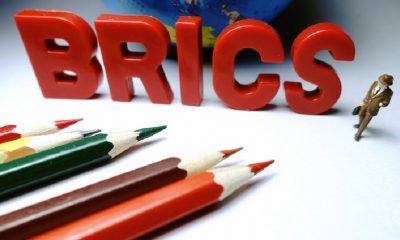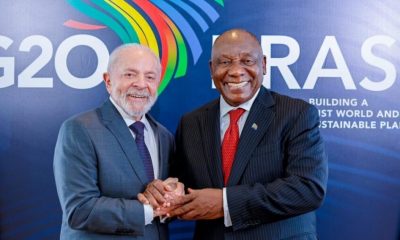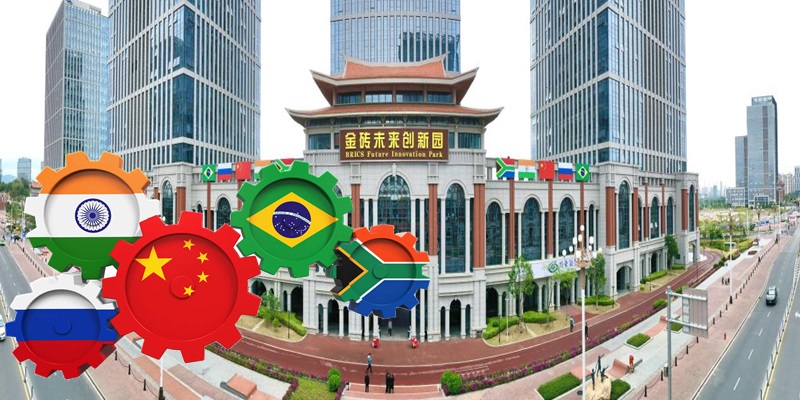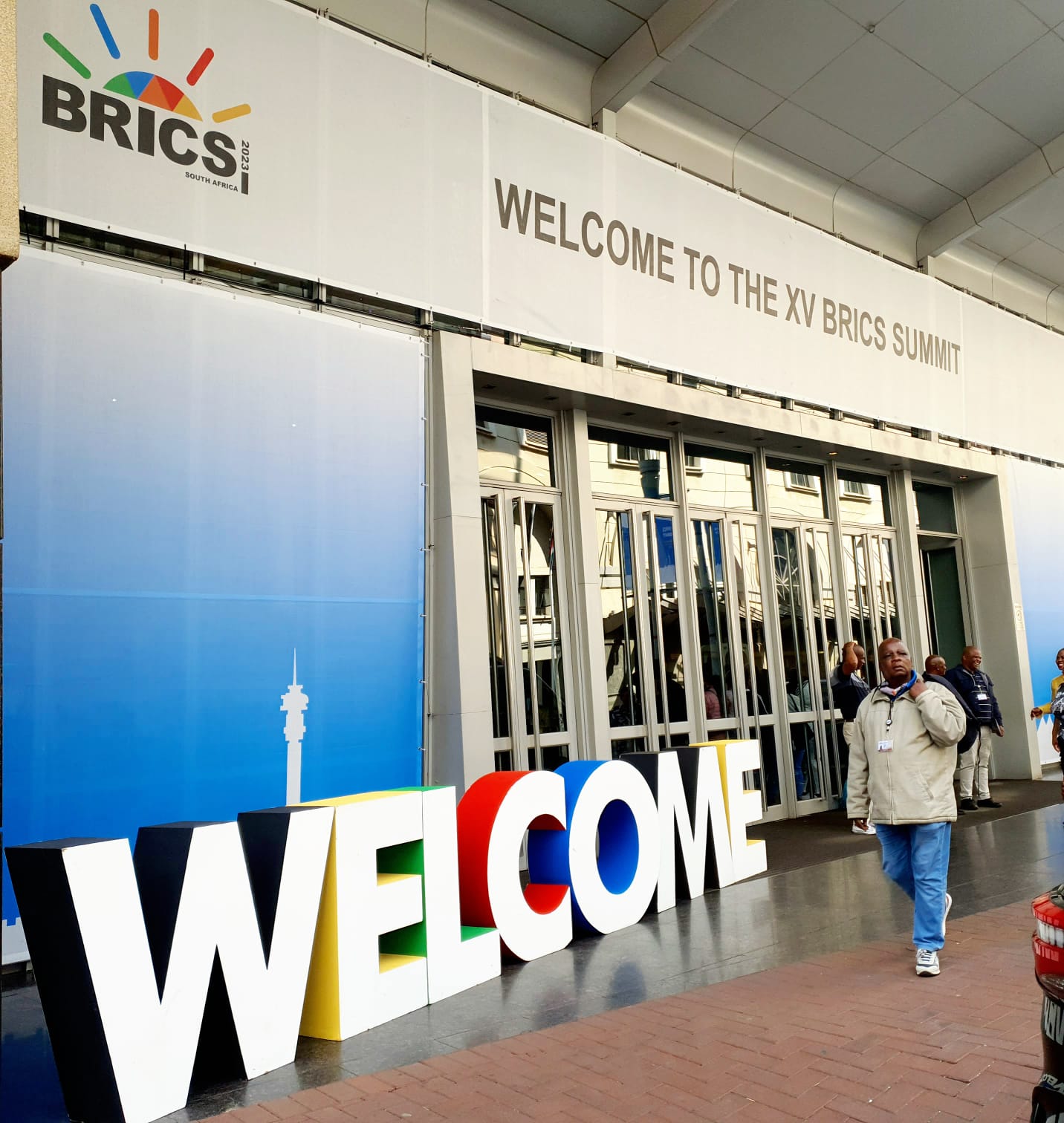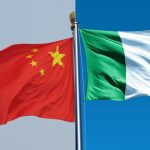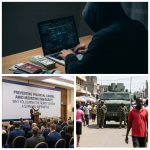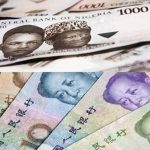Feature/OPED
BRICS Mapping De-dollarization for Emerging New World
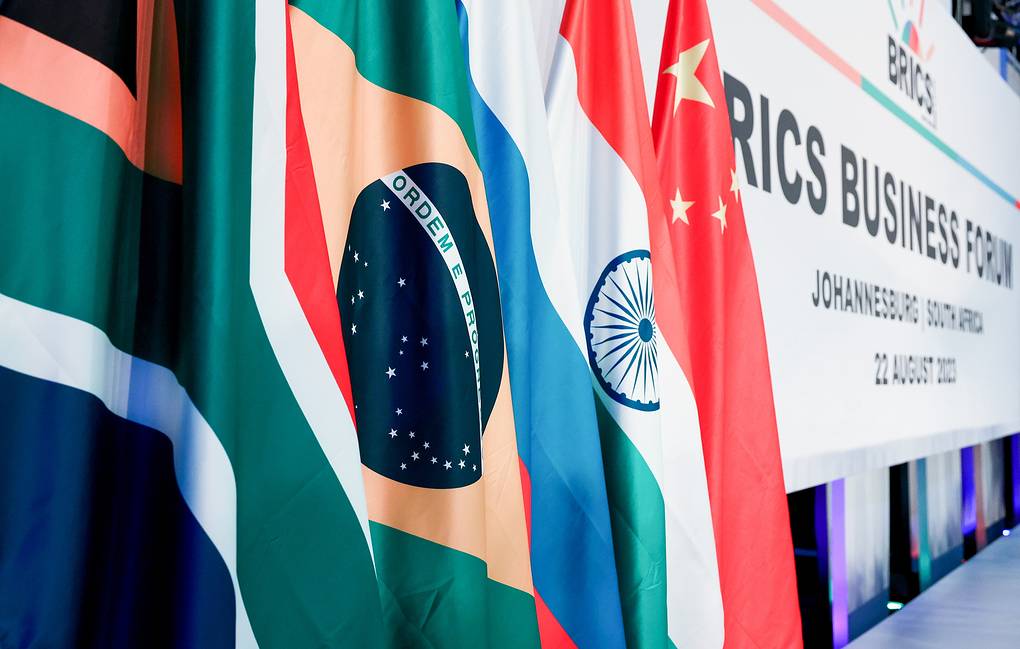
By Professor Maurice Okoli
For the five BRICS (Brazil, Russia, India, China and South Africa) members, de-dollarization has become the latest common buzzword in English. Long before the highly-praised Johannesburg’s 15th BRICS summit, considered a very important step forward on the way to deepening interaction in the sphere of trade and investment with the nations of Global South, all the five BRICS leaders have made it their priority task to find their common currency so as not to depend on the United States dollar in the emerging new world.
Understandably, the primary reason is further delineating from United States hegemony and global dominance. In fact, the BRICS desire to facilitate global de-escalation, assist each other in solving issues concerning mutual interests and, in future, transact businesses in what they now popularly refer to as BRICS common currency. This question is already enshrined in the final comprehensive document that sets forth the general guidelines and principles of the association after the historic August 22-24 meeting held in South Africa.
South Africa was the summit host. Chinese and Brazilian presidents, the Indian Prime Minister, the Russian Foreign Minister, and leaders and representatives from some 50 other countries are in attendance. On August 22, Russian President Vladimir Putin addressed the BRICS business forum, among several significant issues highlighted the accelerating momentum of de-dollarization.
In a virtual address, Putin also criticized the sanctions policy of Western states, saying such practice is seriously affecting the international economic situation. He said the unlawful freezing of assets of sovereign states constitutes a violation of free trade and economic cooperation rules.
Putin said that efforts were in progress to create an international reserve currency based on a basket of currencies of the association’s member countries. Some experts believe such a currency may protect the BRICS countries from sanction risks associated with settlements in dollars and euros.
The objective and irreversible process of de-dollarizing the economic ties is gaining pace. Russia has been working hard to fine-tune effective mechanisms for mutual settlements and monetary and financial control. As a result, the share of the US dollar in export and import operations within BRICS is declining: last year, it stood at only 28.7 per cent, according to the Russian leader.
Russia has always advocated for switching trade between member countries away from the U.S. dollar and into national currencies, a process in which the BRICS New Development Bank would play a big role. “The objective, irreversible process of de-dollarizing our economic ties is gaining momentum,” he said.
He also urged BRICS to increase its role in the international monetary system and expand the use of national currencies. Noticeably, Russia, being one of the founding patrons of BRICS, acts as a unifying force behind and in the organization and largely determines that its role is strengthened for the future.
President of the People’s Republic of China, Xi Jinping, attended the BRICS Summit, for the third time, held in South Africa. The distinctive difference is that at this 2023 summit, the world has entered a new period of turbulence and rapid transformation.
“We gather at a crucial time to build on our past achievements and open up a new future for BRICS cooperation. We should deepen business and financial cooperation to boost economic growth.,” he emphasized. “We need to leverage the role of the New Development Bank fully, push forward reform of the international financial and monetary systems, and increase the representation and voice of developing countries.”
An English version of the article by Chinese President Xi Jinping titled “Sailing the Giant Ship of China-South Africa Friendship and Cooperation Toward Greater Success” widely published ahead of the 15th BRICS Summit in South African media, including The Star, Cape Times, The Mercury as well as Independent Online, also underlined the practical concept of multilateralism and push for the building of a more just and equitable international order.
South African companies are also racing to invest in the Chinese market to seize the abundant business opportunities, and they have made important contributions to China’s economic growth. The China-South Africa relationship is standing at a new historical starting point. It has gone beyond the bilateral scope and carries increasingly important global influence.
China and South Africa should be fellow companions sharing the same ideals. As an ancient Chinese saying goes, “A partnership forged with the right approach defies distance; it is thicker than glue and stronger than metal and rock.” Therefore, there is a need to increase experience sharing on governance and firmly support each other in exploring a path to modernization that suits both national conditions.
“We should fear no hegemony and work with each other as real partners to push forward relations amid the changing international landscape. In the face of the profound changes unseen in a century, a strong China-Africa relationship will provide more fresh impetus to global development and ensure greater stability. Looking ahead into the next 25 years,” he wrote in the article.
Indian Prime Minister Narendra Modi also underlined the current significance of BRICS in dealing with the world’s tensions and disputes, but most importantly, de-dollarization amid economic challenges. “In 2009, when the first BRICS summit was held, the world was just coming out of a massive financial crisis. At that time, BRICS emerged as a ray of hope for the global economy. In the present times, to shape strategies for economic cooperation, in particular ways of increasing trade settlements in local currencies and BRICS expansion.”
Brazilian President Luiz Inacio Lula da Silva believes the world will see massive changes in the coming years. “When we talk about Brazil and BRICS, we show that it is possible to create a new world. We don’t want to argue with anyone. We want integration between continents and equal conditions for all,” Lula da Silva said.
According to him, establishing partnerships between private sectors is a very relevant dimension of BRICS that gives life and continuity to the relations between the countries; participation in the global economy has been expanding since the first Summit of Heads of State and Government. “We have already surpassed the G7 and now account for 32% of the world GDP in purchasing power parity. Projections indicate that emerging and developing markets will present the highest growth rates in the coming years,” he explained in his speech.
According to the IMF, while growth in industrialized countries is expected to drop from 2.7% in 2022 to 1.4% in 2024, the expected growth for developing countries is 4% this year and the next. This shows that the economy’s dynamism is in the Global South – and BRICS is its driving force. Brazil’s total trade with BRICS increased from US$48 billion in 2009 to US$178 billion in 2022 – a 370% growth since the group was created.
Brazil’s BRICS Direct Foreign Investment stock increased 167% between 2012 and 2021, reaching 34.2 billion dollars. Today, almost 400 companies from the bloc operate in Brazil. The decision to establish the New Development Bank was a milestone in effective collaboration among emerging economies. The joint bank must be a global leader in financing projects that address the most pressing challenges.
In arguing, the president pointed to the BRICS New Development Bank (NDB) as a way to offer its financing alternatives suited to the needs of developing countries. “The creation of a currency for trade and investment transactions between BRICS members increases our payment options and reduces our vulnerabilities”, he said, reinforcing that developing countries need an international financial system that helps implement structural changes instead of feeding inequalities.
By diversifying payment sources in local currencies and expanding its network of partners and members, the NDB is a strategic platform to promote cooperation among developing countries. In this strategy, engagement with the African Development Bank will be central. At the multilateral level, BRICS stands out as a force favouring a fairer, more predictable, and equitable global trade. As of December, Brazil will occupy the presidency of the G20. The presence of three BRICS members in the G20 Troika will be a great opportunity for us to advance issues of interest to the Global South.
Reading through various reports, Peter Koenig, a geopolitical analyst and also a non-resident Senior Fellow of the Chongyang Institute of Renmin University in Beijing and a former Senior Economist at the World Bank, convincingly argues that many see the BRICS as the salvation from the West, from sanctions, from the dollar impositions, from debt enslavement – from trading restrictions… from outright theft of their currency reserves in foreign countries.
As a byline to the all too frequent western theft of reserve funds and gold…! But is this the purpose of the BRICS – providing shelter from the last onslaught of the West, led by the United States and her vassals – the Europeans? And is it right – that some of the BRICS leaders are constantly vacillating between the US and the BRICS solid core – China and Russia? Modi, for example, seems to be leaning towards whatever camp – West or East – he feels gives him more advantages.
Koenig further explained that many BRICS countries still depend on the US dollar as the bulk of their reserve currency, the main trade currency. De-dollarization for many is not happening overnight. Therefore, a common strategy is needed. To begin with and to avoid the dollar – trading among BRICS members (and even outside BRICS) with local currencies instead of dollars. This is relatively easy; for example, China and Argentina have done it for a long time. In the short-to-medium term – what might help and may become a necessity is having a common BRICS Trading Currency.
There has been a gradual shift away from trading in US dollars, and instead, countries adopted trading in their local currencies or in a currency of common use by trading partners, for example, the Chinese Yuan. Latin America – especially Argentina, Brazil, Mexico, and Venezuela – consistently uses local currencies or the Chinese Yuan to avoid the dollar. Avoiding the dollar is foremost for its protection from US sanctions. Increasingly, more countries will use this new trading mode – equitable and peaceful.
The Turkish edition Dunya notes that since the United States imposed financial sanctions on Russia last year, de-dollarization has gained momentum. The BRICS countries forced transactions using non-dollar currencies. After the start of the Ukrainian conflict, Russia, Iran, Brazil, Argentina, and Bangladesh went for broke against the United States, using the Chinese yuan instead of the dollar in trade.
Four Reasons for De-dollarization:
— Over-reliance on a single currency, changes in US monetary policy, and possible US sanctions or restrictions carry risks. In addition, the US government has run a large budget deficit for many years. And this raises concerns about inflation and the value of the dollar.
— The United States has been involved in many geopolitical conflicts in recent years, primarily the wars in Iraq and Afghanistan. These conflicts have resulted in heightened tensions between the US and other countries, making some states less willing to use the dollar.
— China, the world’s second-largest economy and an increasingly influential player in world trade is encouraging the use of its currency as an alternative to the dollar.
— Cryptocurrencies such as bitcoin, which are not subject to government control, have become attractive to those looking for an alternative to the dollar.
There are so many arguments and discussions about the question of global currency. But one more interesting analytical conclusion is here. Michael G. Plummer, Director at SAIS Europe and Eni Professor of International Economics at Johns Hopkins University, believes the global system gains from having an internationally accepted currency like the US dollar as a medium of exchange, unit of account and store of value. But its role will diminish at the margin at a rate that will be the function of exogenous factors, such as changes in the international marketplace, and endogenous factors, such as how the United States faces its financial and trade challenges.
As widely seen across the world, the BRICS bloc is rapidly gathering stronger momentum for a more democratic and multipolar world order that respects the sovereignty, equality, and diversity of all nations. The United States and Western allies often deeply underestimate its future growth and role on the global stage but have heightened interests in shaping its instruments, such as the BRICS Bank, which is likened to IMF and the World Bank, becoming the alternative organization, especially for the Global South.
Notwithstanding all the arguments, views and observations, Russia, isolated by the United States and Europe over its invasion of Ukraine, is keen to show Western powers it still has friends. In contrast, Brazil and India have forged closer ties with the West. There are still justifiable arguments, though, that the group’s members have long been thwarted by some internal divisions and, to some extent, a lack of coherent vision.
In Johannesburg, BRICS, under the 2023 chairship of South Africa, Cyril Ramaphosa, has achieved an appreciable milestone. As stipulated in the 10-point joint declaration, BRICS will continue, through its collective efforts, working steadily towards shaping an alternative new system across the ASEAN, Africa and Trans-Atlantic. BRICS, with an additional six members, is now home to more than 40% of the world’s population and more than a quarter of global GDP, the bloc’s ambitions of becoming a global political and economic player. As the new Chair, Russia will hold the next BRICS summit in Kazan in October 2024.
Professor Maurice Okoli is a fellow at the Institute for African Studies and the Institute of World Economy and International Relations, Russian Academy of Sciences. He is also a fellow at the North-Eastern Federal University of Russia. He is an expert at the Roscongress Foundation and the Valdai Discussion Club.
As an academic researcher and economist with a keen interest in current geopolitical changes and the emerging world order, Maurice Okoli frequently contributes articles for publication in reputable media portals on different aspects of the interconnection between developing and developed countries, particularly in Asia, Africa and Europe. With comments and suggestions, he can be reached via email markolconsult(at)gmail(dot)com
Feature/OPED
Preventing Financial Crimes Amid Mounting Insecurity: Why Following the Money is Now a Survival Imperative
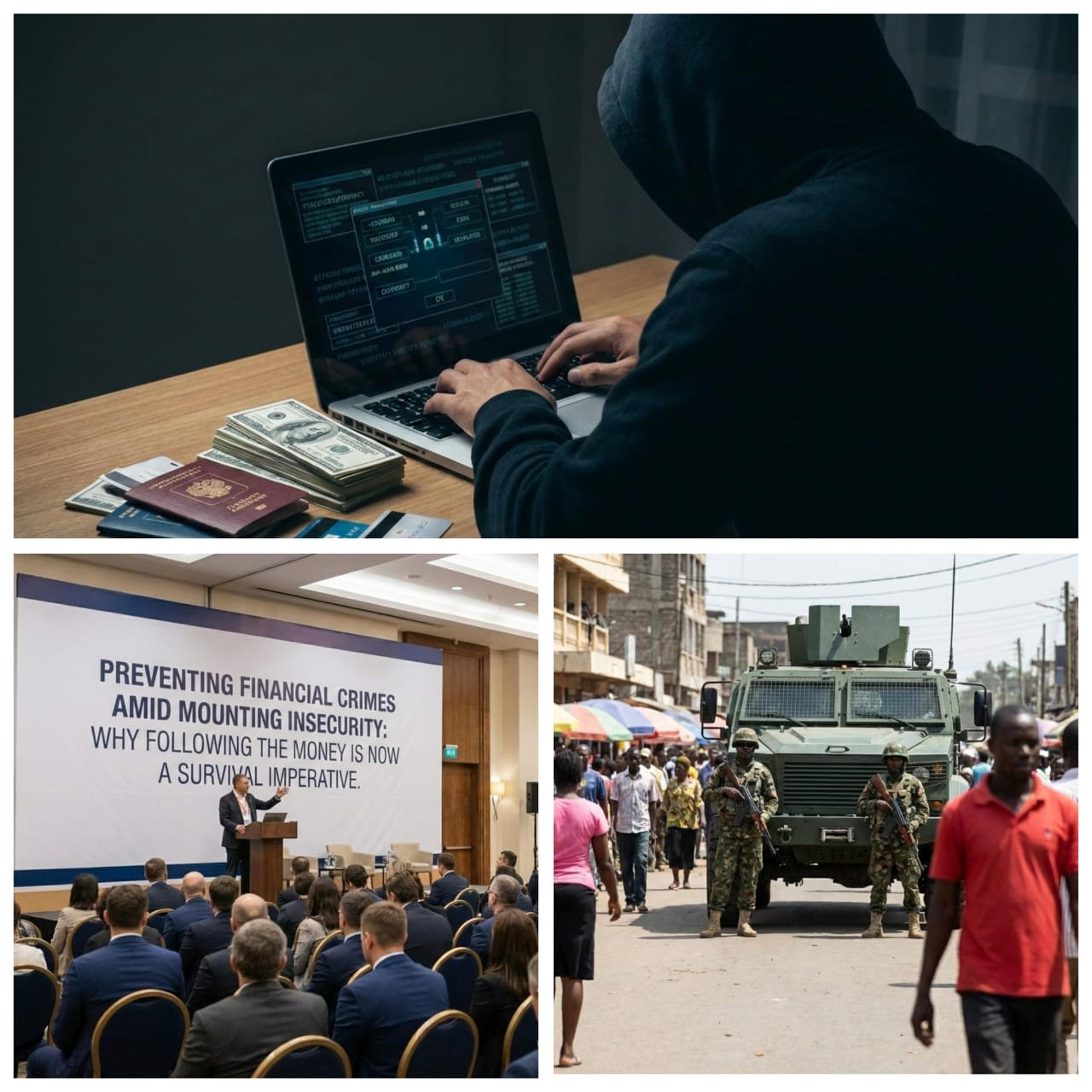
By Blaise Udunze
Nigeria today faces a sobering dual reality: a deepening security crisis and an entrenched financial-crime ecosystem that quietly feeds, sustains, and normalises that crisis. Across the North, Middle Belt, and parts of the South, kidnappers, bandits, insurgent cells, political actors, compromised security agents, and a complex chain of financial facilitators operate within a shadow economy of violence, one that generates billions, claims thousands of lives, and steadily erodes the authority of the state.
For over a decade, security experts and Nigeria’s international partners have warned that no meaningful progress will be made against insecurity unless the financial oxygen sustaining violence is cut off. Yet the country continues to prosecute its anti-terrorism efforts largely through military responses, as though the conflict could be resolved solely on the battlefield. What remains missing is a decisive, transparent, and politically courageous confrontation with the economic networks that make insecurity profitable.
This war is not only about guns and bullets. It is about money.
Money moves fighters.
Money buys weapons.
Money fuels political desperation.
Money underwrites chaos.
Until Nigeria addresses the financial pipelines behind its insecurity, the crisis will continue to reproduce itself.
Kidnapping: The Lucrative ‘War Fund’ Sustaining Insurgency
The rise in mass kidnappings is neither accidental nor spontaneous. It has evolved into a rational, structured, revenue-generating enterprise.
Appearing on Channels TV’s Politics Today in October 2025, Yusuf Datti Baba-Ahmed warned that insurgent and bandit groups now treat ransom payments as reliable “war funds.” The data support his claim.
A 2024 survey by the National Bureau of Statistics (NBS) found that Nigerians paid N2.2 trillion in ransom between May 2023 and April 2024. This astonishing sum does not account for unreported payments made through informal negotiators, mobile transfers, or unregulated community channels.
Kidnapping has matured into a fully formed economy with well-defined roles: negotiators, informants, logistics providers, cash couriers, and security collaborators. Proceeds are reinvested in weapons, motorcycles, communication devices, safe houses, and even land acquisitions.
In the words of a security analyst, “Every successful kidnapping is a fundraiser.”
Sabotage from Within: Keffi’s Explosive Memo and a System Built to Fail
If Nigeria’s external security threats are troubling, the internal compromises are even more alarming.
A leaked memo by Major General Mohammed Ali Keffi accused senior government and military officials of diverting billions of naira earmarked for arms procurement under former Chief of Army Staff, Lt. Gen. Tukur Buratai. Keffi’s allegations included:
– Weapons paid for but never delivered
– Falsified battlefield reports
– Civilian casualties mislabelled to justify inflated expenditures
– Political interference obstructing investigations into terror financing
His claims echoed the earlier warning by Gen. T.Y. Danjuma, who accused sections of the military of working in concert with armed groups and abandoning vulnerable communities.
Keffi’s memo became even more consequential following the 2025 detention of former Attorney General Abubakar Malami by the EFCC over allegations of money laundering, terrorism financing and suspicious financial activity linked to 46 bank accounts.
Together, these revelations paint a disturbing picture: even as Nigerians endure mass abductions, elements within the political and security elite appear to be enabling or shielding the financial networks behind the violence.
Why the Crisis Persists: A Financial Crime Lens
Nigeria’s insecurity cannot be divorced from the environment in which illicit finance thrives. Key enablers include:
- Informal Economies and Unregulated Cash Flows
With over 70 percent of rural transactions still cash-based, terror groups exploit:
– Hawala networks
– POS and mobile-money agents
– Cattle markets and mining sites
– Barter systems centred on livestock and grains
These channels operate beyond the reach of AML/CFT systems.
- Identity Fraud and Weak KYC Enforcement
– Criminal networks routinely open accounts with:
– Fake NINs
– Compromised SIM cards
– Recycled BVNs
– Mule identities
- Collusion within Financial Institutions
The EFCC estimates that up to 70 percent of financial crimes involve bank personnel, primarily through:
– Unauthorised cash withdrawals
– Suppressed Suspicious Transaction Reports (STRs)
– Manipulated internal alerts
- Weak Prosecution and Political Interference
Cases drag on for years, and many evaporate entirely before reaching court often due to political considerations.
- Ungoverned Spaces
Large territories across the North serve as hubs for:
– Arms trafficking
– Illegal mining
– Kidnap-for-ransom camps
– Cross-border smuggling
Public Patience Thins: NLC Moves to the Streets
Public frustration is reaching a boiling point. On December 10, the Nigeria Labour Congress (NLC) announced a nationwide protest scheduled for December 17, citing the “degenerating security situation” and the rise in mass abductions.
The NLC condemned the November 17 abduction of female students in Kebbi, noting that security personnel had been withdrawn from the school shortly before the attack. The union called the act “dastardly and criminal” and directed all affiliates and civil-society partners to fully mobilise for the protest.
This marks a significant shift. For the first time in years, Nigeria’s most influential labour body is placing insecurity at the centre of national mobilization, further underscoring the argument that the current crisis is not simply a security failure but a systemic breakdown of governance, accountability, and financial integrity.
The Financial Engine of Terror: The 23 Suspects Who Moved Billions
A Sahara Reporters investigation uncovered a network of 20 Nigerians and three foreign nationals allegedly linked to the financing of Boko Haram and ISWAP. Their transactions, running into hundreds of billions, were quietly channeled through personal and corporate accounts.
Among those named:
– Alhaji Saidu Ahmed, Zaria businessman: N4.8bn inflows
– Usaini Adamu, Kano trader with 111 accounts: N43bn inflows, N50bn outflows
– Muhammad Sani Adam, forex and precious stones dealer: N54bn across 41 accounts
– Yusuf Ghazali, a forex trader linked to UAE-convicted terrorists, operated 385 accounts
– Ladan Ibrahim, a Sokoto official, is accused of diverting public funds
– Foreign actors included the late Tribert Ayabatwa (N67bn inflows) and Nigerien arms dealer Aboubacar Hima, who moved over $1.19 million.
Strikingly, several of the suspects arrested in 2021 were quietly released without trial, continuing a pattern of impervious investigations and political bottlenecks.
This network confirms a painful truth: Nigeria’s insecurity is not driven solely by men wielding rifles in the bush. It is sustained by individuals in cities, businesses, and bureaucracies, people with access, influence, and remarkable financial mobility.
The Political Dimension: Irabor’s Revelation and the Unnamed Sponsors
The political undertone of Nigeria’s insecurity was reinforced by the former Chief of Defence Staff, Gen. Lucky Irabor (rtd), who admitted that politicians were among those financing terror groups. According to him, some trials were conducted “away from public consumption.”
His statement revived key questions:
– Why is the state shielding the identities of terror sponsors?
– Who benefits from the secrecy?
– What political consequences are being avoided?
Security sources told TruthNigeria that Nigeria’s published list of 19 terror financiers in 2024 represented only a fraction of the full network.
Baba-Ahmed’s accusation that former Kaduna Governor Nasir El-Rufai was part of the political forces that aggravated Northern insecurity, an accusation the former governor has previously denied, adds further urgency to demands for transparency.
The Human Cost: Expanding Killing Fields
Despite repeated assurances, violence continues to spread:
– 303 students and 12 teachers abducted in Niger State
– 38 worshippers kidnapped in Kwara
– Simultaneous raids across Plateau, Kaduna, Benue, and Niger
– Whole communities uprooted by weekly attacks
As Amnesty International observed, “In many rural communities, only the graveyards are expanding.”
SBM Intelligence now describes large portions of the North as “open killing fields,” areas where the state’s influence has collapsed, and community vigilantes have become the default security providers.
Expert Voices: Why Nigeria Must Finally Follow the Money
Security experts converge on a single message: Nigeria cannot defeat terrorism without dismantling its financial infrastructure. Dr. Friday Agbo, a security researcher, disclosed, “Terror groups survive because their financial lifelines remain untouched.”
Jonathan Asake, analyst and former SOKAPU president, said, “Publish the full Dubai list. Without transparency, impunity will remain the norm.”
Gen. Irabor (rtd.) revealed, “There are politicians involved. The conflict is multi-layered: ideology, criminality, and political manipulation.”
These assessments underscore one reality: ideology is secondary. Money is primary. It is the oxygen of Nigeria’s terror landscape.
What Must Change
Nigeria must elevate financial crime to the level of a national-security emergency. Key reforms include:
– Integrating BVN-NIN-SIM identity databases and upgrading real-time monitoring
– Targeting illicit markets: illegal mining hubs, cattle markets, unregulated border posts
– Deploying AI-driven analytics to detect layered transactions, mule networks, and ransom flows
– Strengthening bank compliance units and protecting whistleblowers
– Improving inter-agency intelligence sharing (EFCC, NFIU, DSS, NDLEA, Police, CBN)
– Criminalising unexplained wealth, especially in conflict zones
– Investing in safe-school infrastructure, rural policing, and local reporting channels
Choosing Truth Over Convenience
Nigeria’s two-front war is neither mysterious nor new. It is a well-documented, financially engineered crisis protected by silence, vested interests, and institutional decay. The NLC’s mobilisation signals a turning point; citizens are unwilling to accept official evasions while insecurity intensifies. To end this crisis, Nigeria must:
– Expose and prosecute terror financiers
– Purge corrupt insiders in the security system
– Dismantle ransom economies
– Strengthen financial intelligence
– End political protection for criminal networks
Until these reforms are pursued with integrity, billions will continue to move, weapons will continue to flow, and Nigeria will continue to bleed.
Blaise, a journalist and PR professional, writes from Lagos, can be reached via: [email protected]
Feature/OPED
Championing Ethical Sourcing Within Dairy Communities

Human Rights Day often centres on themes of dignity, equity, and freedom. Yet for many Nigerians, these rights are not debated in courtrooms they are expressed in the ability to access nutritious food, build meaningful livelihoods, and secure a healthy future for their families. Nutrition, in this sense, becomes a fundamental human right.
Despite a growing population and rising nutrition needs, Nigeria faces a pressing dairy reality. The country remains heavily dependent on dairy imports, leaving nutritional access vulnerable and local capacity underdeveloped. This is not just an economic concern; it is a human one. When families cannot easily access affordable, high-quality dairy, the foundations of health and development are weakened.
It is within this context that Arla Nigeria operates not merely as a dairy company, but as a nutrition powerhouse committed to nourishing a nation. Our ambition extends beyond selling products. We are working to build the foundations of a stronger, more resilient local dairy sector that supports food security, economic participation, and national progress.
At the heart of our efforts is the Damau Integrated Dairy Farm in Kaduna Statea fully operational modern farm designed to demonstrate what responsible, efficient, and scalable dairy production can look like in Nigeria. Arla Nigeria produces its own milk on-site, ensuring quality, safety, and consistency as we continue building the systems required for a sustainable local value chain. In fact, until our yoghurt factory launches, the reverse is true: some stakeholders purchase milk from us.
But infrastructure alone is not the story. What truly matters is the human impact surrounding the farm.
Arla Nigeria has been intentional about engaging and empowering the communities around Damau. By creating employment opportunities for local residents, providing skills development, and contributing to community growth, we are ensuring that the benefits of dairy development extend beyond production lines. This is development rooted in people where progress is measured in livelihoods improved and opportunities created.
As Arla Nigeria continues to expand operations, our long-term commitment remains clear: to contribute meaningfully to local milk sourcing and value chain development, strengthening Nigeria’s capacity to feed itself. Backward integration is not a slogan for Arla Foods; it is a structured pathway with building responsibly and sustainably. From farm systems to future household milk initiatives, the goal is to create a model that supports farmers, enhances productivity, and drives economic inclusion in the years ahead.
On Human Rights Day, the conversation often revolves around preventing harm avoiding exploitation, ensuring fair labour, and upholding ethical standards. These are essential, but they are only the beginning. True respect for human rights means creating enabling systems that allow people to thrive.
With Arla Foods, that begins with nutrition. Milk is a super food, rich in essential nutrients that support growth and development. Ensuring access to such nutrition contributes directly to national well-being and productivity. When we help secure a healthier population, we strengthen the foundation for education, economic participation, and long-term prosperity.
This is why Arla believes that dairy is not just food it is nutrition, livelihood, and progress. By investing in sustainable production, community development, and future local sourcing capabilities, Arla Nigeria is contributing to food security and economic growth in a tangible, measurable way.
Ultimately, ethical business is not defined by corporate language or labels. It is defined by the stability, nourishment, and dignity it brings to people’s lives. As Nigeria celebrates Human Rights Day, let us recognise that the right to nutrition and the opportunity to build a better future are among the most powerful rights we can help protect.
Feature/OPED
In Praise of Nigeria’s Elite Memory Loss Clinic

By Busayo Cole
There’s an unacknowledged marvel in Nigeria, a national institution so revered and influential that its very mention invokes awe; and not a small dose of amnesia. I’m speaking, of course, about the glorious Memory Loss Clinic for the Elite, a facility where unsolved corruption cases go to receive a lifetime membership in our collective oblivion.
Take a walk down the memory lane of scandals past, and you’ll encounter a magical fog. Who remembers the details of the N2.5 billion pension fund scam? Anyone? No? Good. That’s exactly how the clinic works. Through a combination of political gymnastics, endless court adjournments, and public desensitisation, these cases are carefully wrapped in a blanket of vagueness. Brilliant, isn’t it?
The beauty of this clinic lies in its inclusivity. From the infamous Dasukigate, which popularised the phrase “arms deal” in Nigeria without actually arming anything, to the less publicised but equally mystifying NDDC palliative fund saga, the clinic accepts all cases with the same efficiency. Once enrolled, each scandal receives a standard treatment: strategic denial, temporary outrage, and finally, oblivion.
Not to be overlooked are the esteemed practitioners at this clinic: our very own politicians and public officials. Their commitment to forgetting is nothing short of Nobel-worthy. Have you noticed how effortlessly some officials transition from answering allegations one week to delivering keynote speeches on accountability the next? It’s an art form.
Then there’s the media, always ready to lend a hand. Investigative journalists dig up cases, splash them across headlines for a week or two, and then move on to the next crisis, leaving the current scandal to the skilled hands of the clinic’s erasure team. No one does closure better than us. Or rather, the lack thereof.
And let’s not forget the loyal citizens, the true heroes of this operation. We rant on social media, organise a protest or two, and then poof! Our collective short attention span is the lifeblood of the Memory Loss Clinic. Why insist on justice when you can unlook?
Take, for example, the Halliburton Scandal. In 2009, a Board of Inquiry was established under the leadership of Inspector-General of Police, Mike Okiro, to investigate allegations of a $182 million bribery scheme involving the American company Halliburton and some former Nigerian Heads of State. Despite Halliburton admitting to paying the bribes to secure a $6 billion contract for a natural gas plant, the case remains unresolved. The United States fined the companies involved, but in Nigeria, the victims of the corruption: ordinary citizens, received no compensation, and no one was brought to justice. The investigation, it seems, was yet another patient admitted to the clinic.
Or consider the Petroleum Trust Fund Probe, which unraveled in the late 1990s. Established during General Sani Abacha’s regime and managed by Major-General Muhammadu Buhari, the PTF’s operations were scrutinised when Chief Olusegun Obasanjo assumed office in 1999. The winding-down process uncovered allegations of mismanagement, dubious dealings, and a sudden, dramatic death of a key figure, Salihijo Ahmad, the head of the PTF’s sole management consultant. Despite the drama and the revelations, the case quietly faded into obscurity, leaving Nigerians with more questions than answers.
Then there is the colossal case of under-remittance of oil and gas royalties and taxes. The Federal Government, through the Special Presidential Investigatory Panel (SPIP), accused oil giants like Shell, Agip, and the NNPC of diverting billions of dollars meant for public coffers. Allegations ranged from falsified production figures to outright embezzlement. Despite detailed accusations and court proceedings, the cases were abandoned after the SPIP’s disbandment in 2019. As usual, the trail of accountability disappeared into thin air, leaving the funds unaccounted for and the public betrayed yet again.
Of course, this institution isn’t without its critics. Some stubborn Nigerians still insist on remembering. Creating spreadsheets, tracking cases, and daring to demand accountability. To these radicals, I say: why fight the tide? Embrace the convenience of selective amnesia. Life is easier when you don’t worry about where billions disappeared to or why someone’s cousin’s uncle’s housemaid’s driver has an oil block.
As World Anti-Corruption Day comes and goes, let us celebrate the true innovation of our time. While other nations are busy prosecuting offenders and recovering stolen funds, we have mastered the fine art of forgetting. Who needs convictions when you have a clinic this efficient? Oh, I almost forgot the anti-corruption day as I sent my draft to a correspondent very late. Don’t blame me, I am just a regular at the clinic.
So, here’s to Nigeria’s Memory Loss Clinic, a shining beacon of how to “move on” without actually moving forward. May it continue to thrive, because let’s face it: without it, what would we do with all these unsolved corruption cases? Demand justice? That’s asking a lot. Better to forget and focus on the next election season. Who knows? We might even re-elect a client of the clinic. Wouldn’t that be poetic?
Now, if you’ll excuse me, I have a new scandal to ignore.
Busayo Cole is a Branding and Communications Manager who transforms abstract corporate goals into actionable, sparkling messaging. It’s rumored that 90% of his strategic clarity is powered by triple-shot espresso, and the remaining 10% is sheer panic. He can be reached via busayo@busayocole.com.
-

 Feature/OPED6 years ago
Feature/OPED6 years agoDavos was Different this year
-
Travel/Tourism9 years ago
Lagos Seals Western Lodge Hotel In Ikorodu
-

 Showbiz3 years ago
Showbiz3 years agoEstranged Lover Releases Videos of Empress Njamah Bathing
-

 Banking7 years ago
Banking7 years agoSort Codes of GTBank Branches in Nigeria
-

 Economy3 years ago
Economy3 years agoSubsidy Removal: CNG at N130 Per Litre Cheaper Than Petrol—IPMAN
-

 Banking3 years ago
Banking3 years agoFirst Bank Announces Planned Downtime
-

 Banking3 years ago
Banking3 years agoSort Codes of UBA Branches in Nigeria
-

 Sports3 years ago
Sports3 years agoHighest Paid Nigerian Footballer – How Much Do Nigerian Footballers Earn





